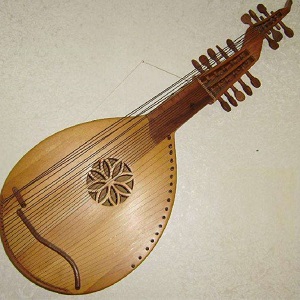Torban
 The TORBAN (or Teorban) is a uniquely Eastern-European instument that combines the features of the Baroque Lute and the Zither. In addition to a normal set of strings on the neck, it has a set of additional unfrettable strings in both the treble and the bass register.
The TORBAN (or Teorban) is a uniquely Eastern-European instument that combines the features of the Baroque Lute and the Zither. In addition to a normal set of strings on the neck, it has a set of additional unfrettable strings in both the treble and the bass register.
The term TORBAN(Teorban) predates the existence of the instrument itself--it previously denoted any European theorbo (or lute) that found its way into Poland & Ukraine. The term when applied to the torban proper could be either an adaptation of THEORBO, or a contraction of TEORbo+BANdura. Its precedents were earlier lute-zither hybrid instruments (at least 3 are known), which include Francesco Landini's "serena serenarum", Tiffenbrucker's "polyphant" and the anonymous Kobza in the Krakow Mus.
The invention of the Torban may be attributed to a specific individual. Sometime between 1736-1740, a Polish Paulite monk from Jasna Gora named Tuliglowski invented an instrument "per modi bandura aut teorban efformati"; he named his instrument "tuli di gambe" [sic!]. Tulignowski was rewarded for a performance on his invented instrument by the Emperor Charled VI in Vienna, where Tuliglowski went in the retinue of Prince Lubomirski. To date, no information on Tuliglowski and his "tuli di gambe" has been found beyond one document found by Polish musocologist Marcin Ludwicki.